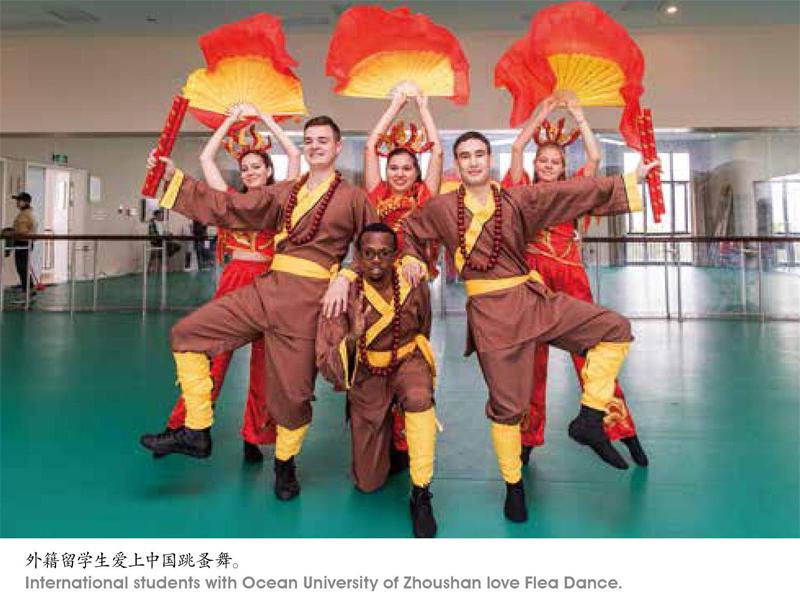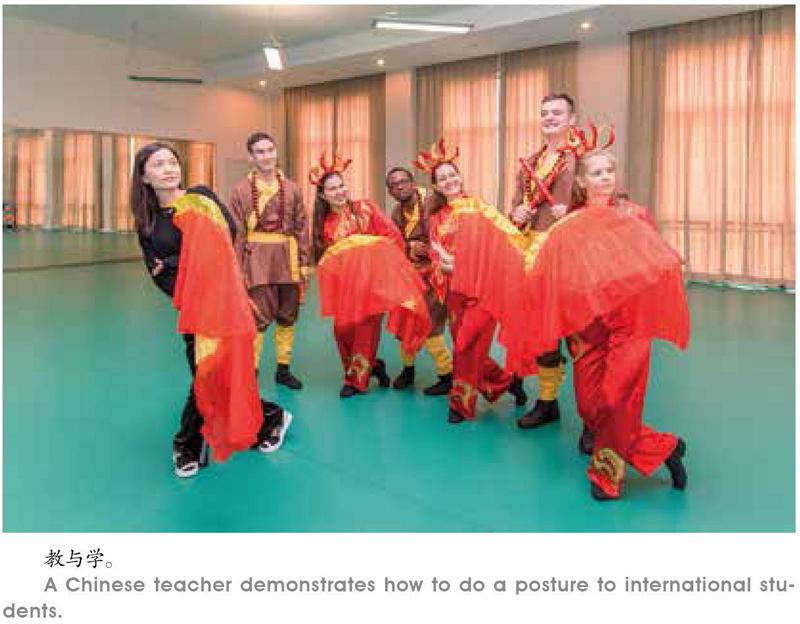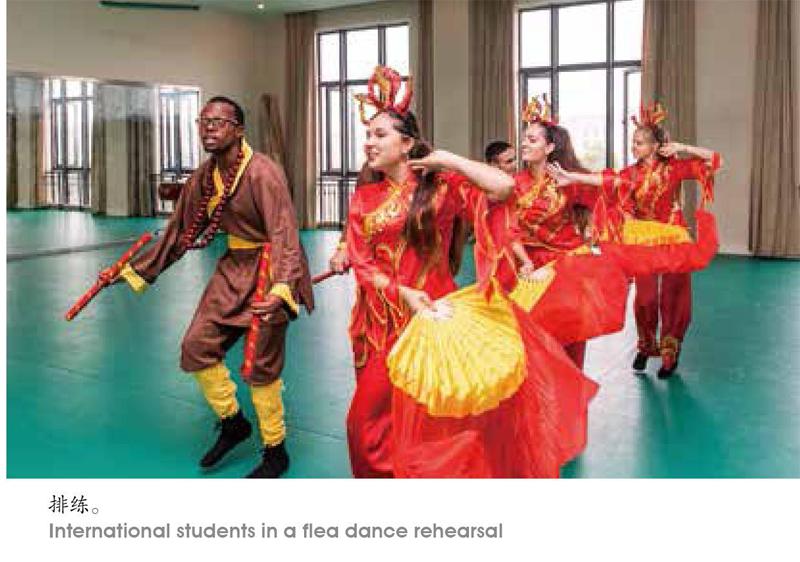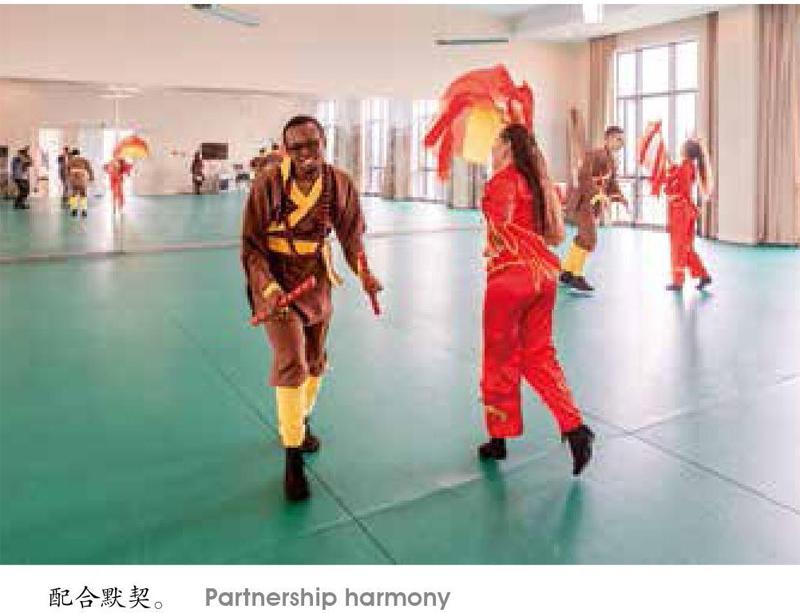外籍留学生爱上中国跳蚤舞
2018-05-09林上军陈玲刘超杰
林上军?陈玲?刘超杰
墻壁上挂满红彤彤的中国结,满屋子洋溢着欢快的歌声。早春时节,舟山群岛地名工作室、定海美之声演唱团邀请25名来自8个国家的浙江海洋大学外籍留学生,与舟山市民一起载歌载舞,共迎新春。
优雅唯美的旗袍秀、热情激昂的中国鼓、婉转悠扬的越剧、汉风浓郁的古筝表演……一个个中国传统(非遗)节目令留学生们如痴如醉。
笔者从浙江海洋大学国际合作交流处了解到,该校有一支由留学生组成的舟山特色非物质文化遗产表演队——跳蚤舞队。
跳蚤舞,原是流传在海岛迎神赛会、喜庆丰收时表演的一种民间舞蹈。后发展成祭灶神仪式舞蹈,以示送旧迎新,祈求消灾免祸,故民间又称“跳灶舞”。12年前,跳蚤舞被列为浙江省非物质文化遗产保护名录。
跳蚤舞由男女二人表演,男角(济公)身穿僧衣,头戴僧帽,腰系草绳,一闪左,一闪右,阻止火神行进。女角(火神)身穿红绿花袄,一手握花伞,一手提香篮子,左一闪,右一闪,躲着济公前进,构成驱赶意境。
据《定海县志》记载,“跳蚤舞”因舞姿形似跳蚤而得名。跳蚤舞形成于清代乾隆年间,从福建传至舟山沈家门渔港。跳蚤舞原为情绪性舞蹈,无情节、无具体人物,因舞姿酷似跳蚤而得名。1922年,白泉镇私塾老先生章孝善,将当地流传的民间故事《济公斗火神》中的济公阻拦火神娘娘的桥段引入舞蹈。
笔者发现,那些留学生表演跳蚤舞非常认真,一招一式,有板有眼。化妆、戴头饰、整服装,严谨而又不失活泼,男角(济公)身穿僧衣帽,颈套须珠,腰系草绳;女角(火神)身穿红绿花袄,手握折扇。整个舞蹈轻松活泼、夸张诙谐。
据浙江海洋大学舞蹈教学指导老师孙靓介绍,跳蚤舞在海大传播已有5年。为了更好地了解与传承这一民间文化,从2012年起,她对“跳蚤舞”进行全面详实的调查研究,但单靠理论研究无法良好传承。2013年,该校成立了一支跳蚤舞队,让大学生认识并学习跳蚤舞。此外,每年孙靓会安排两到三次的外出交流机会,让队员们开展艺术实践活动,与民间艺人进行学习交流。截至目前,浙江海洋大学培养了至少60名跳蚤舞表演者,“跳蚤舞”后继有人。其中一支由6名留学生组成的跳蚤舞表演队尤其引人注目,他们分别来自俄罗斯、乌克兰、哈萨克斯坦、坦桑尼亚等国。
这一舟山特色舞蹈的传承者扩展到国际留学生,缘于浙江省教育厅、外侨办和浙江电视台教育科技频道每年举办的“梦行浙江”外国留学生中华才艺展。孙靓在2016年为参加“梦行浙江”的海大留学生编排舞蹈,考虑到这群热情的学生来自“一带一路”沿线国家,学习传统地域文化也可以作为一种尝试和突破。
孙靓说这其中的一个小插曲让她很触动,初选有很多人报名,一个非洲的学生没选上但每天都坚持训练,一个俄罗斯学生穿上济公装以后不肯脱。被选上的留学生们都喜欢跳蚤舞,练习很认真。她感受到了民间舞蹈强大的艺术感染力:文化背景不同,但艺术是相通的。
除了跳蚤舞,打莲湘、舟山锣鼓等具有舟山本土特色的艺术形式也被纳入留学生学习表演的范围。2017年5月,普陀虾峙岛77岁老人陆昌沅将跟随了他20多年的虾峙锣鼓送给了这群留学生。
坦桑尼亚的Bhoke和俄罗斯的喀秋莎是跳蚤舞中的一对搭档,也是悟性很高、学得很快的同学。两人都是海大食品科学与安全工程专业硕士生。
喀秋莎觉得:“这种舞蹈非常有趣,尤其是女孩子们跳的那部分非常美,从老师讲解里也了解到这舞蹈背后的故事原来是关于男女互相爱慕,简直太有趣了,让我们很有学习的动力。”Bhoke喜欢这一舞蹈的理由则是“它让我感到非常享受”。刚开始他们遇到了很大的困难,无论是语言障碍还是舞蹈动作,慢慢地,他们领悟了舞蹈的要领,随着舞蹈技术的不断进步,大家越发喜爱。

喀秋莎说:“我第一次去练习时,很吃惊地看到Bhoke也在那里,后来我们就在老师安排下成为了跳蚤舞搭档。练习舞蹈占据了很多课余时间,但对于这样一种机会,我们感到非常感恩,也愿意全身心投入。刚开始的时候,我们需要更多练习,有时候我和Bhoke就跑到学校外面去练习。”Bhoke说:“跳舞会让我们接触到更多的人,它提供了更多与他人相处以及共度快乐时光的机会,而且我们还有更多机会去不同地方。”
提及未来打算,Bhoke表示,希望在语言和文化学习上有更大提升,另外“我真正想得到的是与中国学生们的友好关系,更希望能建立起我们坦桑尼亚人民与中国人民之间的友谊桥梁;很多坦桑尼亚人还不了解中国,我要把在中国舟山所经历的一切告诉他们。”
浙江海洋大学国际交流处副处长钟伟良表示,舞蹈只是留学生生活中很小的一部分,可是他们却通过舞蹈感受到了中国海岛独特的文化;学习结束后,他们一部分人会选择回国,会把他们学习舞蹈的故事讲述给更多的人。
浙江海洋大学还计划让更多的留学生去了解和体验中国传统文化,一起讲好中国故事。浙江海洋大学的老师们深信,中国的传统艺术会更好地绽放于“一带一路”沿线国家。
‘Flea Dance is a native folk celebration popular in Zhoushan, the countrys largest archipelago in East China Sea. In good old days, island residents held the dance to pay homage to the god of sea and celebrate harvest. Gradually, the flea dance evolved into a special ritual performance at the sacrificial ceremony in honor of the kitchen god. In 2006, the dance was inscribed on Zhejiang Provinces list of intangible cultural heritage.
The dance is performed by a man and a woman. The man is dressed as a monk and the woman as the goddess of fire holds an umbrella in one hand and a flower basket in the other. The monk moves right and left to stop the goddess from coming forward and the goddess moves left and right to move forward and drive the monk away.
According to the Annals of Dinghai County, the dance originated in Fujian, a province to the south of Zhejiang in the years of Emperor Qianlong of the Qing Dynasty. The dance migrated from the south to Shenjiamen, the biggest fishing port in Zhoushan. At first, the dance presented no plot and displayed no characters. In 1922, the dance became what it is today thanks to Zhang Xiaoshan, an old teacher of a private school in White Spring Town (Baiquan Town) on Dinghai Island. The dance was choreographed to dramatize a scene of the popular local folk tale called “The Mad Monk Tries to Stop Goddess of Fire”.
Sun Liang, a dance teacher with Ocean University of Zhejiang based in Zhoushan, began to conduct a comprehensive study of the folk dance in 2012. The initial study results indicated that theoretical research wouldnt do very much to carry on the tradition. In 2013, she founded a flea dance team at the university, giving students an opportunity to learn how to do this stint. She made arrangements for the team to stage a show two or three times every year to the general public and compare notes with folk artists. By now, over 60 students have learned how to do the flea dance.
In 2016, Sun made an inquiry among international students of the university to see if they would be willing to do the flea dance. To her surprise, they responded enthusiastically. Many signed in, but the team was not ready to take them all in. Some who were not selected came to practice again and again.
Bhoke from Tanzania and Katyusha from Russia are a pair of dancers who are taking the same graduate course of food science and safety engineering. Katyusha was surprised to find her classmate there the first time she went to the practice room. The teacher paired them for the flea dance and they were happy to be chosen. They spent a lot of time practicing on and off the campus in order. The dancing gave them ample chances to meet people and visit different places. Katyusha finds it very interesting to do the beautiful dance and feels motivated by the story behind the dance.
At present, the university flea-dance team has six international students from Russia, Ukraine, Kazakhstan, and Tanzania.
“Dancing is only a small component of the life of international students on the campus, but they can certainly feel the unique characteristic of Chinas island lifestyle. Some of them will go back home after graduation and they will pass on their dancing experience to more people,” says Zhong Weiliang, deputy director of international exchanges department of Ocean University of Zhejiang.
The university plans to better expose international students to the depth and breadth of Chinas traditional culture so as to help promote the Belt & Road Initiative. Nowadays, international students with the university can take courses on more local folk art traditions.
